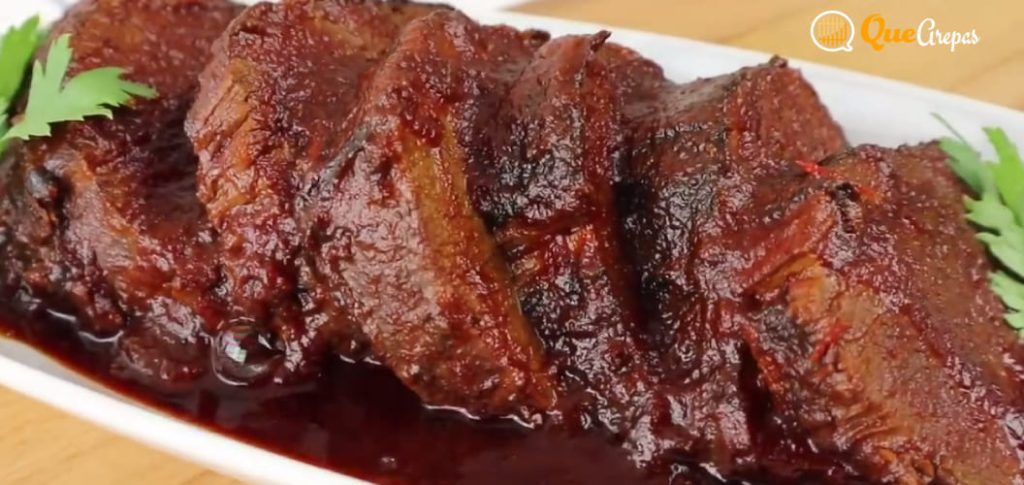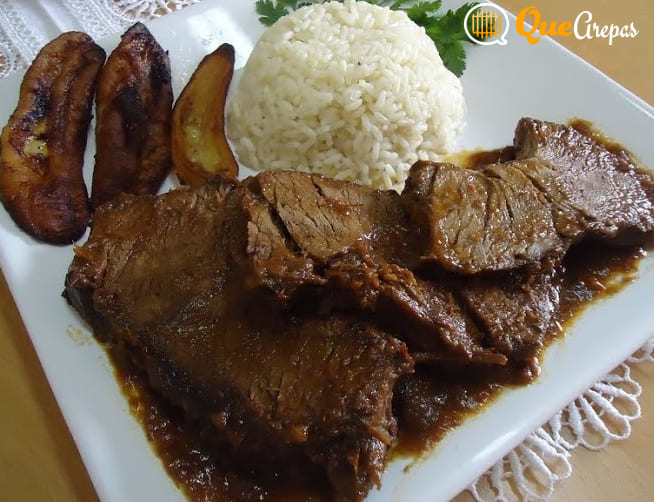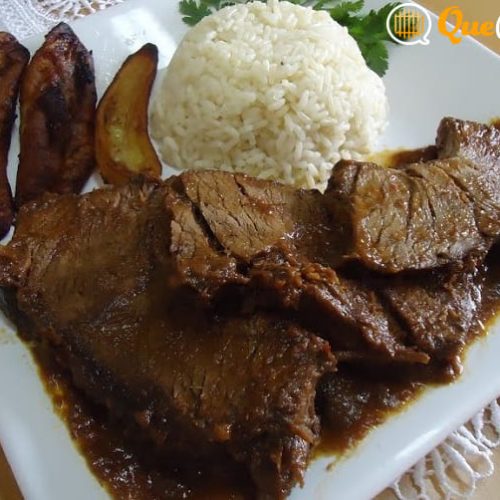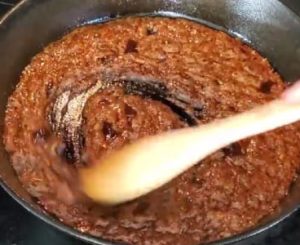Asado Negro: a delicious blend of flavors and cultures

If you are a lover of good food and like to discover new flavors and culinary cultures, you can't miss the asado negro. This emblematic dish of Venezuelan cuisine is a delicious mix of cultural influences and flavors that will make you travel through the history and traditions of our country. From the juicy beef in its thick, dark sauce, to the spices and herbs that add a distinctive flavor and aroma, asado negro is a dish you can't miss.
In this article, I will tell you everything you need to know about asado negro, its origin and history, its ingredients and preparation, and how it has evolved over time to become one of the most representative dishes of Venezuelan gastronomy. Get ready to discover a delicious mix of flavors and cultures in every bite!
Origins and history of the asado negro
Asado negro is an emblematic dish of Venezuelan cuisine that has its roots in the era of Spanish colonization. It is believed that asado negro originated in the Barlovento region, in the state of Miranda, during the slavery era, when African slaves used similar culinary techniques to cook the beef provided by their masters.
Asado negro became a popular dish in the Barlovento region and gradually spread to other regions of the country. Over time, asado negro has evolved and adapted to the different regions and cultures of Venezuela, becoming one of the most representative dishes of Venezuelan gastronomy.
Although there is no official version of the origin of the name "asado negro", it is believed to be due to its dark color and the thick, dark sauce that accompanies it. Another theory suggests that the name is due to the ingredients used in the preparation, such as panela or papelón, which give a sweet and dark flavor to the sauce.
Today, asado negro is a dish found in most Venezuelan restaurants and homes, and has become a symbol of the country's culture and culinary tradition. There are different variants of asado negro throughout the country, each with its own recipe and preparation technique, demonstrating the diversity and richness of Venezuelan gastronomy.

Ingredients and preparation
Asado negro is a dish that takes time and patience to prepare, but the result is tender, juicy beef with a thick, dark sauce full of flavor. Here are the ingredients and preparation of asado negro:
To prepare the asado negro, ingredients such as beef, onion, paprika, garlic, red wine, beef broth, tomato puree, Papelón or panela, cumin, oregano, ground black pepper, salt and vegetable oil are needed.
The preparation of black roast requires time and patience, as the meat must simmer for several hours until tender and juicy. The thick, dark sauce is one of the key elements of black roast and is full of flavor thanks to the spices and herbs used in the preparation.
Below is the recipe courtesy of Temperos e Sabores and their youtube channel.

Venezuelan Asado Negro Recipe
Ingredients
For the meat maceration
- 1 unit plastic bag for storing the meat with the ingredients
- 1 unit 1 ½ Kg. piece of beef, round boy cut. Approx.
- 1 cup Red wine
- 1 unit head of crushed garlic
- 1 unit Cumin to taste
- 1 unit Salt to taste
- 1 unit Pepper to taste
To prepare the roast with its sauce
- 1 1/2 cup Corn oil
- 1 cup Shredded paperboard
- 1 unit large onion cut into small cubes
- 1 unit red pepper
- 1/2 unit sprig of garlic
- 1 kg ripe tomatoes without skin and seeds
- 1 unit Worcestershire sauce to taste
- 2 unit Laurel leaves
- 1 unit Guayabita to taste (Jamaica pepper)
- 4 unit cloves (sweet cloves)
- 1 unit Black pepper to taste
- 1 unit Salt to taste
- 1 unit Water
Instructions
Meat maceration
- To prepare the asado negro, it is advisable to previously clean the boy and leave a part of the layer of fat that covers it. Then, it should be seasoned with crushed garlic, salt and pepper to taste, and bathed with red wine.
- It is important to cover it and let it rest in the refrigerator for at least 12 hours so that it macerates properly. It is recommended to keep the boy in a plastic bag to avoid odors in the refrigerator. This way, the black roast will have a more intense and delicious flavor.
Preparation of the roast in its sauce
- Heat the oil very well in a pot and add the paprika (you can substitute sugar, but the flavor that paprika gives is unique).
- When it is dark, seal the meat in this mixture until it is practically black, give it time, so that it is really dark. Separately cut the onions into small cubes, pass the tomatoes through hot water to remove the skin, remove the seeds and leave them in pieces. Add the onions to the pot, let them become transparent and add the tomatoes, a little water, salt and pepper, let them cook covered until tender. Add water if necessary, so that it does not dry out.
Video
Notes
Nutritional Information
Asado negro is a typical Venezuelan dish prepared with beef, so its nutritional value is mainly related to the protein and iron it provides. Below is a table with approximate nutritional information for a portion of 100 grams of asado negro:- Calories: 210 kcal
- Protein: 21 g
- Fat: 10 g
- Carbohydrates: 8 g
- Fiber: 1 g
- Iron: 2 mg
- Calcium: 10 mg
- Vitamin C: 0 mg
Best preparation tips
Black roast is a dish that requires time and patience to prepare, but with some tips and advice you can achieve a delicious and flavorful result. Here are some of the best tips for preparing black roast:
- Choose the right meat: To prepare a delicious black roast, it is important to choose the right meat. The ideal cut of meat for black roast is the rear end or round, as these are cuts that cook slowly and remain tender and juicy.
- Browning the meat: Browning the meat before cooking is an important step in the preparation of black roast. Browning the meat seals in the juices and creates a browned coating that adds flavor to the dish.
- Simmering: Black roast should be simmered for several hours to keep the meat tender and juicy. It is important to cook over medium-low heat and cover the pot so that the meat cooks in its own juices and does not dry out.
- Let the meat rest: After cooking the meat, it is important to let it rest for a few minutes before slicing it, so that the juices are evenly distributed and the meat is juicier.
- Reducing the sauce: If the black roast sauce is too runny, it may need to be reduced to bring it to the right consistency. To do this, you can leave the pot uncovered and cook over medium heat until the sauce reduces and thickens.
- Accompaniments: It is traditionally served with white rice, fried ripe plantains and salad, but it can also be accompanied with other dishes and side dishes according to each person's preference. Some options include arepas, fried yucca, baked potatoes, among others.
Suggestions for presentation
Asado negro is a dish that is traditionally presented in a large platter and served with white rice, fried ripe plantains and salad. However, there are some presentation suggestions that can make the dish look even more appetizing and attractive. Here are some suggestions for the presentation of Venezuelan asado:
- Garnish with fresh herbs: To give a touch of color and freshness to the dish, you can garnish with fresh herbs such as cilantro, parsley or chives.
- Serve in individual plates: If you want to present the black roast in a more elegant way, you can serve it in individual plates and decorate it with some additional sauce and a touch of fresh herbs.
- Additional accompaniments: In addition to the traditional accompaniments, other ingredients can be added to complement the flavor of the black roast, such as avocado, fresh cheese, cherry tomatoes, among others.
- Presentation in small portions: If you wish to present the asado negro as an appetizer or tapa, you can cut the portions into small pieces and present them on a tray with toothpicks.
- Serve with additional sauces: For those who like to experiment with different flavors, additional sauces can be prepared to accompany the black roast, such as an avocado sauce or a chimichurri sauce.
Cultural influences on asado negro venezolano
Asado negro is a dish that combines different cultural influences, resulting from the mixture of flavors and culinary techniques from different regions and cultures of Venezuela. Among the main cultural influences on asado negro, the following stand out:
- African: It is believed that African slaves who arrived in Venezuela during the time of Spanish colonization used similar culinary techniques to cook the beef provided by their masters. This is why black asado has roots in African culinary culture, with the use of spices and herbs such as cumin, oregano and black pepper.
- Indigenous: Panela or papelón, a key ingredient in the preparation of asado negro, is a product of indigenous origin that has been used in Venezuelan gastronomy for centuries. In addition, the technique of slow cooking beef, which is used to prepare asado negro, is similar to the technique used by the indigenous people to cook meat in pre-Columbian times.
- Spanish: Beef and red wine, two fundamental ingredients in the preparation of asado negro, are products introduced by the Spanish during the colonization period. In addition, the technique of browning the meat before cooking and the use of onion, paprika and garlic in the preparation of the sauce are also Spanish culinary influences.
- Criolla: Over time, asado negro has been adapted to different regions and cultures of Venezuela, and each region has its own variant of the dish. The adaptation of asado negro to the different regions and cultures of the country is a Creole influence in this emblematic dish of Venezuelan gastronomy.
Variants of the asado negro
Asado negro is a dish that varies according to the region and the preference of each person. Here are some of the most popular variations of asado negro in Venezuela:
- Asado negro de Caracas: In the Venezuelan capital, it is prepared with beef cut into large chunks and cooked in a thick, dark sauce based on red wine, paprika, onion, paprika, garlic, cumin, oregano and black pepper. It is traditionally served with white rice, fried ripe plantains and salad.
- Asado negro de Barlovento: In the Barlovento region, it is prepared with beef cut into large chunks and cooked in a thick, dark sauce based on paprika, onion, paprika, garlic, cumin, oregano and black pepper. Unlike other variants, in Barlovento rum is used instead of red wine to cook the meat. It is traditionally served with coconut rice, fried ripe plantains and salad.
- Asado negro de la Costa Oriental: In the East Coast of Venezuela, it is prepared with beef cut into large chunks and cooked in a thick, dark sauce based on paprika, onion, paprika, garlic, cumin, oregano and black pepper. Unlike other variants, in the East Coast orange juice is used instead of red wine to cook the meat. It is traditionally served with white rice, fried ripe plantains and salad.
- Asado negro de Los Andes: In the Andes region, it is prepared with beef cut into large chunks and cooked in a thick, dark sauce based on paprika, onion, paprika, garlic, cumin, oregano and black pepper. Unlike other variants, in Los Andes sweet bell pepper is used instead of paprika to flavor the sauce. It is traditionally served with arepas and salad.
- Asado negro vegetarian: For those who prefer a vegetarian option, vegetable proteins such as seitan or tofu can be used instead of beef. The preparation of the sauce is similar to the traditional asado negro recipe, using paprika, onion, paprika, garlic, cumin, oregano and black pepper.
Keep enjoying more Venezuelan food recipes, especially Venezuelan arepas.
Frequently Asked Questions
Where does the black roast originate from?
Asado negro is a typical dish of Venezuelan gastronomy. Its origin is believed to date back to colonial times, when African slaves working in the Creole haciendas cooked beef with ingredients such as panela, garlic and spices to create a tasty and nutritious dish. Over time, asado negro became a traditional Venezuelan food and has become popular in other Latin American countries.
What type of meat is used to make black roast?
Asado negro is made with beef. The most recommended part to prepare this dish is the low loin, although the high loin or the rear end can also be used. It is important that the meat has a little fat so that it remains juicy and tender after cooking. To achieve the characteristic flavor of the black roast, the meat should be marinated with a mixture of garlic, onion, black pepper, cloves, cumin and brown sugar.
How is black roast served?
Asado negro is served sliced and accompanied by white rice, fried ripe plantains and salad. It can also be accompanied with potatoes or boiled yucca. The sauce obtained from cooking the meat is used to bathe the meat before serving and gives it a characteristic sweet and sour flavor. It is a very popular dish for special celebrations such as weddings, baptisms and birthday parties.
If you want to know other articles similar to Asado Negro: a delicious blend of flavors and cultures you can visit the category Comida Venezolana.





